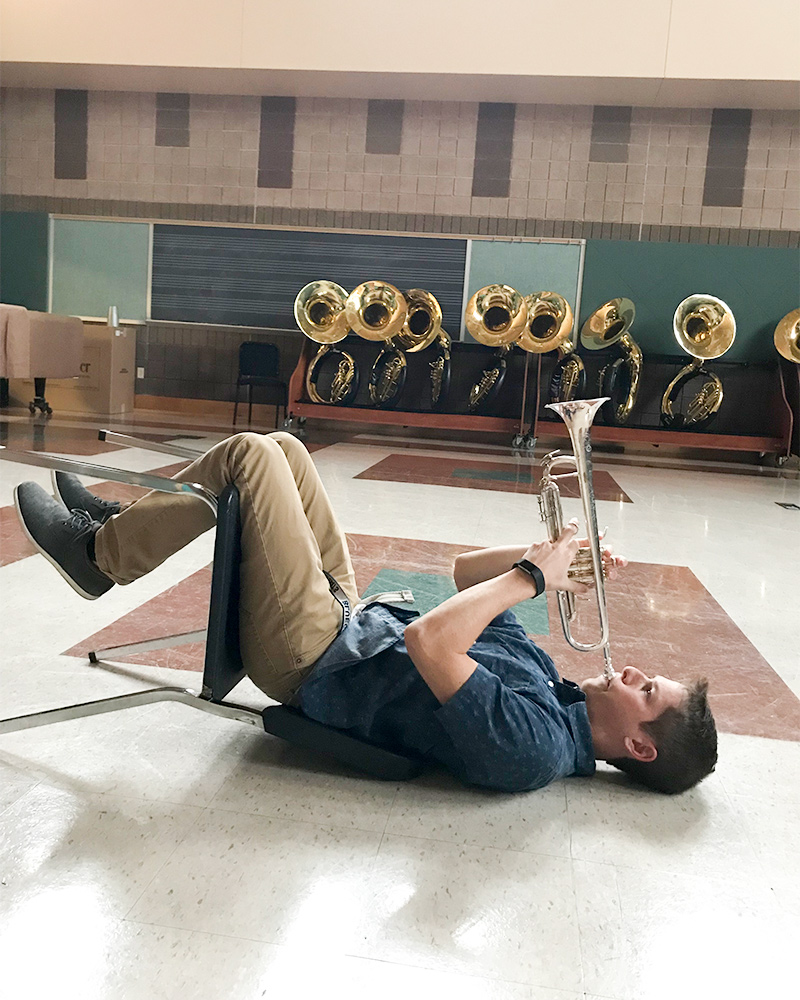
ATTENDEES
Masks are required at all times for all patrons and visitors regardless of vaccination status during all indoor performances taking place at Shenandoah Conservatory. Masks must be worn in the lobby, inside the theatre/concert hall and in the restrooms.
PERFORMERS
Performing artists will perform unmasked only if they are fully vaccinated and have tested negative for COVID-19 within 72 hours of their performance(s).
Learn More >
Joseph Walczyk, trumpet
Saturday, March 26, 2022 at 5:00 p.m.
Armstrong Concert Hall
Shenandoah Conservatory
Escapade
Joseph Turrin (b. 1947)
Concerto for Trumpet and Orchestra
II. Nocturne
Henri Tomasi (1901–1971)
Sonata No. 1 for Trumpet and Piano
I. Lento, Allegro molto
II. Allegretto
III. Allegro con fuoco
Eric Ewazen (b. 1954)
- intermission -
Der Doppelgänger
Gretchen am Spinnrade, Op. 2
Franz Schubert (1797–1828)
Crimson Sky
Anthony DiLorenzo (b. 1985)
All of Me
Gerald Marks (1900–1997) & Seymour Simons (1896–1949)
Escapade
Joseph Turrin is an Emmy and Grammy nominated composer ranging from solo and chamber music to film scores. Escapade, written for the great trumpeter Philip Smith in 1990, is an exciting opener that showcases both technical virtuosity and lyricism on the piccolo trumpet.
Nocturne
Tomasi’s Trumpet Concerto (1948) is, as the title suggests, originally written to be performed with a full orchestra. The piano reduction, written by the composer himself, may be missing the many tone colors an orchestra can provide, but does not lack in expressing the eerie quality of this movement. There are elements of both traditional classical music and jazz influence throughout the work that allow the soloist to play what the composer said is “pure music.”
Schwartz, Elizabeth. “James Lowe, Conductor - Spokanesymphony.org.” Program Notes for Masterworks 6: Music for Valentine’s Day. Spokane Symphony, 2020.
Sonata No. 1 for Trumpet and Piano
Commissioned in 1995 for the International Trumpet Guild, Eric Ewazen’s sonata is a modern masterwork for the trumpet. Following the traditional three-part structure of a Sonata, each movement offers a chance for the soloist to showcase many different styles of playing. The opening movement starts with several fragments of melody which are transformed and expanded on throughout the movement. The second movement contains much longer lyrical lines, allowing for more individual expression for the performers. The third and final movement, labeled Allegro con Fuoco, begins with an aggressive interplay between the trumpet and piano. In a similar fashion to the first movement, there are many fragmented ideas all leading to an intense ending with mixed-meter sections and fast lines from both the trumpet and piano.
Der Doppelgänger
Der Doppelgänger is one of several songs in Schubert’s Schwanengesang (swan song) cycle. Written in the year of his death, the text (by Heinrich Heine) depicts a man seeing his doppelgänger (a double of yourself) while he is standing outside the home of his lost lover. The piano sets a scene of somber darkness through the low register and long sustains at soft dynamics. As the text increases in intensity the melody and dynamic range expand upwards drastically, and settles back down as the man in the text falls back into questions and despair.
Original text:
Translation:
So many a night, so long ago?
Gretchen am Spinnrade Op.2
Gretchen am Spinnrade is widely accepted as Schubert’s first art song, written when he was seventeen years old. The original text by Goethe portrays Gretchen singing about her love for Faust while sitting at a spinning wheel. The perpetual rhythm in the piano depicts the spinning of the wheel, while the voice, or flugelhorn today, carries the melody.
Original Text:
Crimson Sky
Crimson Sky is a work for nine trumpets, dedicated to the late Ryan Anthony for the 2015 Cancer Blows event. Written for nine trumpets, this work utilizes the sonorous colors of the low and high range of the instrument to paint a scene of a beautiful sunset and the many feelings and emotions it evokes.
Notes from Anthony DiLorenzo: “Since I was a kid, I’ve always been intrigued by the magnificent beauty and ominous aspects of sunsets. Whether it’s magical, surreal, or spiritual, these glorious murals in the sky are unique to each one of us. Sometimes, the beauty is so powerful, it can transcend all understanding.”
All of Me
All of Me is a classic jazz standard from the early 1930’s. This song has been recorded by many of the greats, such as Billie Holiday, Dinah Washington, and Frank Sinatra. The well known melody leaves room for interpretation, and the chord changes provide opportunities for exciting improvisation.
Joseph Walczyk is from the studio of Mary Elizabeth Bowden. This recital is presented in partial fulfillment of the requirements for a Doctor of Musical Arts in Performance (Trumpet).
